Goose pimples broke out on a student’s skin in the pitch-black cellar of a Tennessee stop on the Underground Railroad. A visceral sadness seeped into a faculty member in the Memphis hotel room where Martin Luther King was shot on the balcony. The physical presence of the souls of black leaders overwhelmed the group’s bus driver in a Selma church.
These are sacred places, where people commune with those who paid the price for freedom.
One thing that has become clear during the time of corona is the difference between virtual learning from books and screens versus the raw, bone-deep feelings of knowledge that can only come through first-hand experience.

Thirty-one Notre Dame students and 13 faculty, staff and leadership fellows plunged into the latter on a bus journey of the history of the civil rights movement across the southern U.S. just before the pandemic shut off campus life and travel in mid-March.
The Center for Social Concerns offered the Act Justly seminar, a one-credit course culminating in a spring break that was no trip to the beach. Students spent the previous month hearing speakers and discussing seminal readings by civil rights leaders. Stops in Tennessee, Arkansas, Mississippi and Alabama covered a cross section from large state museums to hidden roadside memorials and from veterans of the cause to today’s community leaders.
Students had a hard time picking the most gut-wrenching scene. Was it the bleak landscape of the farm where 14-year-old Emmett Till was killed, or the Jackson home of slain leader Medgar Evers? Was it the bridge in Selma where marchers were beaten, or the church in Birmingham where four girls were killed by a bomb?
For Matthew Aubourg, a junior from Oklahoma City and a group leader on the trip, the Till site struck a nerve.
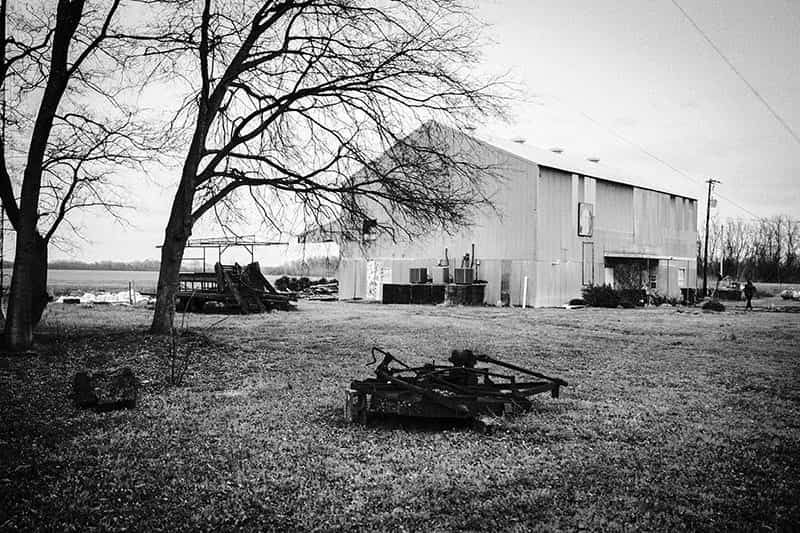
“Just being on that property,” he said. “As soon as we stepped out of the bus, it felt like I was able to have a sense of being in Emmett Till’s shoes. I could see myself in the environment and feel the uncertainty and fear that he felt. That really impacted me in an emotional way that I’m still trying to process.”

For many, intimate new details of familiar stories brought them to life. Evers exiting his car on the right side except for that fateful night. Horse-backed police riding up the steps of a church in Selma to swing batons at marchers running from the Edmund Pettus Bridge.
Others were touched by the less famous incidents and people. The Elaine Massacre that led directly to the right of due process. Viola Liuzzo, a white Detroit mother who was shot for driving a black man during the march to Montgomery. Fannie Lou Hamer, a home-grown Mississippi activist whose modest memorial is hard to locate without local help.
Memphis
The bus left South Bend early and arrived in Memphis late, which didn’t stop the group from a quick trip to Beale Street to see the blues bars and to eat Gus’s World Famous Fried Chicken.

The Lorraine Motel, where King was killed on April 4, 1968, has been transformed into the National Civil Rights Museum. It was a full day’s visit.
The outside of the museum — the neon sign, the balcony, two antique cars — has been precisely preserved, pulling the visitor into the scene of historical photos. The inside has been gutted and replaced with exhibits that move steadily from slavery through Jim Crow laws to its focus on the civil rights movement.


National Civil Rights Museum at the Lorraine Motel, site of the assassination of Martin Luther King, Jr. The wreath hangs on the balcony where King was shot outside his room.
Brown vs. Board of Education. Rosa Parks and the Montgomery bus boycott. Lunch counter sit-ins. Freedom bus rides. Birmingham and Bull Connor. The March on Washington. “I Have a Dream” speech. The Civil Rights Act and Voting Rights Act.
It was a garbage workers’ strike that brought King to Memphis. His final speech spoke of reaching the mountaintop and seemed to hint an acceptance of death: “Mine eyes have seen the glory of the coming of the Lord.” Visitors moved slowly through the preserved rooms #306-7, quiet with the weight of the moment.

In the former boarding house across the street, an adjunct section of the museum covers shooter James Earl Ray, the aftermath of the assassination and his eventual arrest. The window is so close to the motel balcony, it’s a painfully easy shot.
“…to see where he was slain was deeply emotional and brought the course to life in a lot of ways.” – Peter Cajka
Peter Cajka, an assistant teaching professor in American Studies, teaches a class this semester called Civil Rights in America. He and many of his students came on the trip as a pilgrimage and a moment of reflection, a chance to bridge the gap between intellectual and emotional understanding.
“Standing at the Lorraine Hotel where King was assassinated was deeply meaningful,” he said. “We’ve read a lot of his works, which explained his theology and his nonviolent platform. But to see where he was slain was deeply emotional and brought the course to life in a lot of ways.”
Student, faculty and staff participants processed these thoughts in smaller group meetings each night. Two student leaders, who had prepared for weeks, directed the reflections of each group.
Also in Memphis, the group visited the Slave Haven Underground Railroad Museum. The modest antebellum house, which once offered hidden shelter for slaves escaping north to freedom, was jam packed with historical mementos ranging from escaped slave notices to African quilts with map clues in their designs.

A tour traced the passage from Africa across the ocean to bondage and forced labor. The highlight came in the cramped cellar when the guide turned out the lights. The darkness freed the imagination to empathize with the slaves’ fear of being caught.
Tia Wilson, a junior from Saint Louis, said it was a reminder that the fight against injustice started before the 1950s.
“The Slave Haven museum opened my eyes to the fact that there was resistance and civil rights actions and African American intelligence before the civil rights movement. Seeing what those slaves went through on their quest for freedom, going into that basement and looking at the hole they had to crawl through, that really resonated with me.”
Mississippi Delta
Our guide for the Mississippi Delta was Jemar Tisby, a 2002 alumnus and author of “The Color of Compromise” about church complicity in racism. Also a speaker in a pre-trip seminar meeting, Tisby moved to West Helena, Arkansas, after graduation to work with Teach for America, fell in love with the Delta and never left.
“They’re doing what they can to promote history and the truth for change. It was a powerful lesson in reframing.” – Matthew Aubourg, junior
Currently finishing his Ph.D. research, an excited Tisby greeted the Notre Dame group as they got off the bus in Helena: “I feel like my worlds are colliding.”
After quick stops at the Mississippi River and the Delta Cultural Center, the group ate lunch at Tisby’s church and heard a panel that included a teacher, student, state representative and the town’s mayor. The first mention of the Elaine Massacre occurred.

“I grew up here and never heard about it until I read a book in 2010,” said Chris Richey, the state representative. “Then I was driving around with a guy and heard a different version, about African Americans rising up to kill whites. There’s lots of false history. Families from both sides are still here, and both sides don’t want to stir up tension.”
Elaine, Arkansas, is about 25 miles from Helena. In September 1919, black sharecroppers gathered to discuss forming a union to get better payments for their cotton crops. Landowners opposed to unions and dedicated to white supremacy tried to interrupt the meeting and a few were shot. Mobs of whites retaliated over the next week, joined by military soldiers, and killed an unknown number of blacks across several counties, likely at least 200.
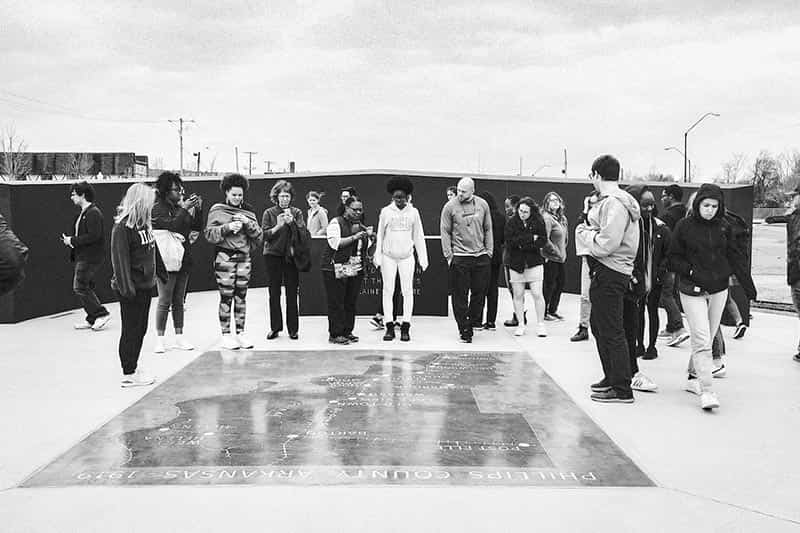

A new memorial outside the Helena courthouse for the Elaine Massacre has forced local residents to grapple with a painful racial history.
Hundreds of black people were also arrested, and the first 12 men tried were sentenced to death. The NAACP took up the case, and in 1923 the U.S. Supreme Court overturned some of the convictions because a setting dominated by a mob spirit violated the prisoners’ right to due process.
Richey said not everyone supported the creation last September of a solemn memorial outside the Helena courthouse to mark America’s worst racial massacre. “It’s 100 years later and we still can’t talk about it,” he said. “We have to come to terms with it to start the healing.”
Another stop proved that well-known stories could also yield new details. In August 1955, Chicagoan Emmett Till was visiting relatives in Money, Mississippi, when he was murdered after allegedly flirting with a white woman. A cotton gin fan was tied around his neck with barbed wire and he was tossed in the Tallahatchie River. His mutilated body, combined with an all-white jury’s acquittal for the murderers, became a catalyst for the civil rights movement.

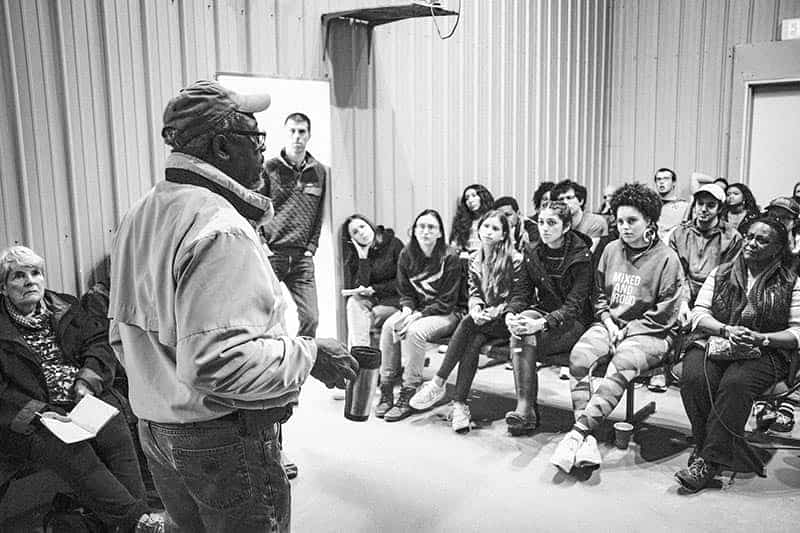

Glendora Mayor Johnny B. Thomas talks to the Notre Dame group at the barn he turned into the Emmett Till Historic Intrepid Center (ETHIC).
In tiny Glendora, Mississippi, Mayor Johnny B. Thomas created a makeshift museum in a metal barn on his property, which is near where Till was thrown in the river. After an introductory film that could be described as unpolished, Thomas spoke about why he created this place to honor Till. He said Till’s white murderers had forced his own father to tie the cotton gin fan around the boy’s neck. The room went silent to contemplate that legacy of guilt.
Aubourg said he appreciated Jemar Tisby’s later comments on the visit.
“I felt so thankful to Jemar for talking about better ways to interpret that experience of people directly involved with the history and community,” Aubourg said. “They’re doing what they can to promote history and the truth for change. It was a powerful lesson in reframing.”
Tisby delivered these remarks at a small burial memorial in Ruleville, Mississippi, for Fannie Lou Hamer, a plantation sharecropper who epitomized the spirit of homegrown activism. After being denied the right to vote, she lost her job and began working as a community organizer at the age of 44. She was threatened, shot at and assaulted by white supremacists, but she helped thousands register to vote and became a powerful speaker and singer of spirituals.

“I try not to put anyone on a pedestal, but it’s hard with Fannie Lou Hamer,” Tisby said. “Most of the movement’s leaders were educated and meant to lead. Hamer only finished sixth grade. In terms of authenticity, no civil rights leader had more integrity.”
“Local effort built this place without any help. I learned what activism means from people in the Delta. I was like you at 22, but I chose here and it’s changed me.”
Jackson
The Mississippi Civil Rights Museum in Jackson covered much of the same ground as the Lorraine Motel museum, with an emphasis on the state’s history. Unsettling voice recordings would occasionally blare out racist catchphrases like, “Who do you think you’re talking to?”
Museums, historical sites and community leaders provided a wide range of perspectives, but a dinner at Voice of Cavalry Church in Jackson introduced first-hand testimony from those who lived through the civil rights movement.
Bishop Thomas Jenkins Sr., pastor of New Dimensions church, was among the first to integrate local public schools near Jackson. “Five black kids went to that school, and four of them had my name,” he said. “You learn how to endure because you know destiny is on your side.”

He was afraid to go to the bathroom all day, had balls chucked at him in gym class, and was punched on the school bus and couldn’t retaliate. The sheriff called one night to say someone would bomb the family’s house and he couldn’t offer protection. The family moved to the back and was lucky that rain put out the fire.

Dr. John Perkins noted that Notre Dame’s former president, Rev. Theodore Hesburgh, C.S.C., was a partner in the civil rights movement. He told the students it’s now up to them to go out in the community to feed and clothe people. “You are my hope for the future,” said Perkins, 89.
At Medgar Evers home, the job of tour guide and storyteller fell to Tony Bounds, archivist at Tougaloo College, to which Myrlie Evers had given the house when the family fled the state. Congress made the home a national monument last year, but Bounds said the park service had yet to allocate any money to staff it.
Evers, a World War II veteran, was the first NAACP field secretary and a prominent activist. He was shot at his home in 1963, yet the white supremacist assassin was twice acquitted before the case was reopened in 1994 and he was finally convicted.
Bounds explained how Evers insisted on a house with a fire-retardant roof and no front door. He always left the carport light off until the family was inside.


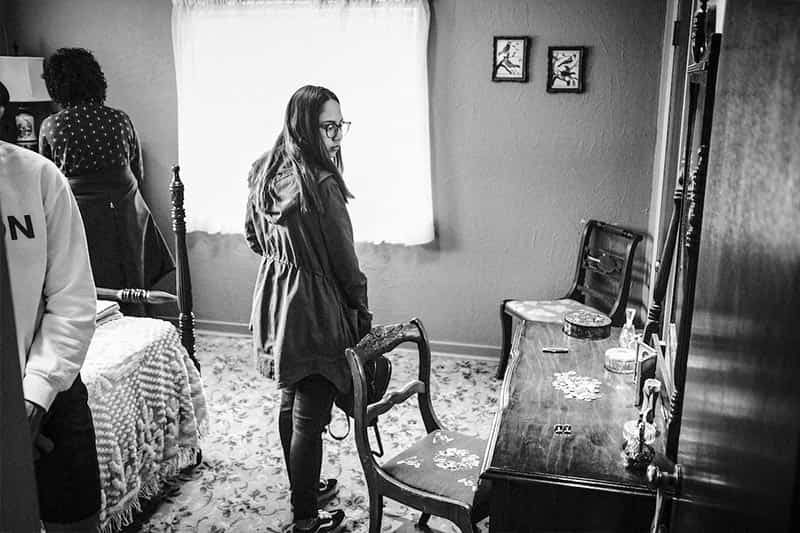
Tougaloo College historian Tony Bounds talks about civil rights activist Medgar Evers at the home where he was assassinated in Jackson, Miss.
“All mattresses on floor, below window line,” Bounds said. “When they came home, everyone got out of car on right side, by the door. He was thinking like a military man. That area over there was brush, where someone could hide, which is what happened.”
The night he was shot, Evers broke routine because he wanted to show his children some t-shirts he had made for an upcoming rally. When he got out on the left side and opened the back door for the shirts, he was an easy target. Inside, the group inspected the spots where the bullet that went through Evers continued into the house, through a wall and hit the kitchen refrigerator.
Wilson said the visit resolved a question that had bothered her: how the Evers could put their children’s lives on the line.
“A Myrlie Evers quote that stood out was, you can kill the man but you can’t kill the movement,” Wilson said. “It shows how the idea was bigger than the man; the idea was eternal in a sense. That was when it clicked for me. They all realized it was more important than them.”
Alabama
By the time the bus crossed into Alabama, there was already some emotional fatigue among the group. It was compounded by the announcement on the way to Selma that Notre Dame had suspended all on-campus classes going forward.

The first stop in Selma was the Brown Chapel AME, where the foot soldiers gathered to hear King and other leaders speak before marching.
Royal Coach bus driver Genita Hicks, 52, a big personality, had already become a student favorite. Hicks said this trip was the best driving experience she’d ever had because she got to see history with the students.
“When I first walked into the church, being a black American, I could feel the presence of the leaders that were here and the struggle they went through,” Hicks said. “Their souls are still in that church.”
Tour guide Joyce Parrish O’Neal captivated the students, sharing her story interspersed with snippets of the spirituals sung during the movement. In 1965, she and other students regularly snuck out of school to gather at the church and protest for their parents’ right to vote.



Her older sister had been arrested and jailed, where the police abused prisoners with clubs and cattle prods. She said her sister’s memories are so strong that she left town and won’t talk about that time. From the church, O’Neal witnessed Bloody Sunday — March 7, 1965 — when marchers tried to cross the Edmund Pettus Bridge but ran into a line of police and deputized thugs.
“We saw people being beaten back from the bridge by riders on horseback,” O’Neal said. “They were actually chasing them down and beating them. The horses rode up the steps of the church as they beat people. Some people were so full of tear gas, they were in the streets trying to get out of their clothing. That tear gas had saturated their hair, clothes, skin.”
“Some of the people who had run back from the bridge had gashes in their head. The blood was running down their faces.”

Belen Carriedo, a first-year graduate student in the Keough School of Global Affairs from Washington state, said this encounter was exactly why she signed up for the seminar.

“What we learned in history class in elementary or high school is definitely not what you see here on the ground,” she said. “That personal experience from people who were there. You don’t get to talk to someone who has lived through that experience every day, or maybe never in your lifetime. It was interesting about how she views the bridge now as Bloody Sunday but also as how things have progressed.”
The students then retraced the walk from the church over the bridge, cell phones waving. At the National Voting Rights Museum on the far side, historian Sam Walker said he was 11 then and went to jail twice. “Just because you’re a young person, doesn’t mean you can’t make a difference,” he said.
That night’s church dinner presented the group with the dismal statistics of crushing poverty in Selma. On a strangely upbeat note, a visit to the roadside memorial of Viola Liuzzo celebrated the white allies who came to help during the movement.

Liuzzo watched the horrors of Bloody Sunday on television and felt compelled to help during a march to Montgomery weeks later. The Detroit mother of five was murdered by members of the Ku Klux Klan as she shuttled fellow activists to the Montgomery airport. Several group members said her sacrifice for others was inspiring.
Nearby, the National Memorial for Peace and Justice in Montgomery is dedicated to the haunting memory of the thousands of black people lynched over the centuries. Corten steel slabs were inscribed with each name and year for every county in the country. The slabs never seemed to stop, hanging in row upon row.

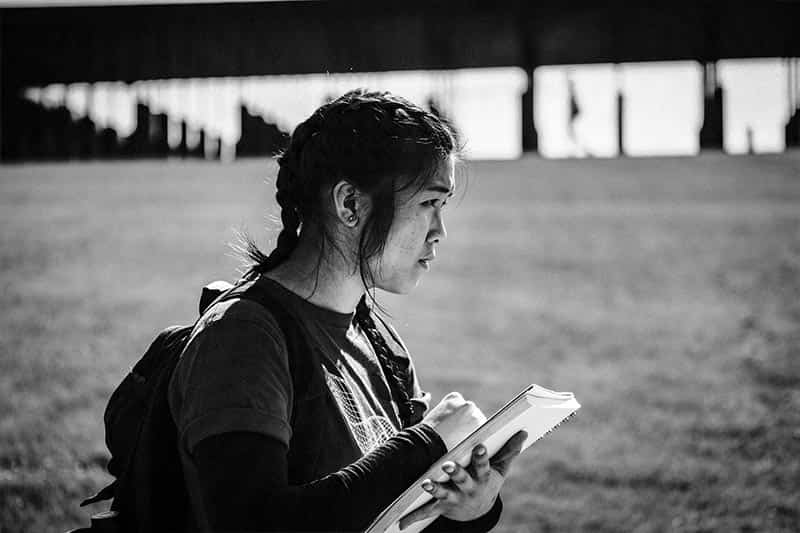

At the National Memorial for Peace and Justice in Montgomery, students Alyssa Sutanto and Matthew Bisner contemplate steel slabs listing the names of America's lynching victims.
The history stops ended in Birmingham, where the group visited the 16th Street Baptist Church. On September 15, 1963, a bomb exploded before Sunday services, killing four young girls and injuring many others. Kelly Ingram Park across the street features active sculptures of the atrocities during the movement.
“I had a visceral reaction to the sculptures. They made me consider the risks that so many people took to protest — not only the physical cost, but the mental and emotional toll of having to fight for your dignity.” – Annie Moran, senior
Annie Moran, a senior from Chicago, said the site perfectly illustrated the first-hand experience that made the trip so worthwhile.
“I had a visceral reaction to the sculptures,” Moran said. “They made me consider the risks that so many people took to protest — not only the physical cost, but the mental and emotional toll of having to fight for your dignity.”
In the end, she said the church’s active status “felt like a testament to the resilience of communities that continue to live out their mission even in the face of loss.”
"freedom" - Google News
May 04, 2020 at 08:30PM
https://ift.tt/2WuzPoi
Retracing the Route of Freedom - ND Newswire
"freedom" - Google News
https://ift.tt/2VUAlgg
https://ift.tt/2VYSiKW
Bagikan Berita Ini














0 Response to "Retracing the Route of Freedom - ND Newswire"
Post a Comment